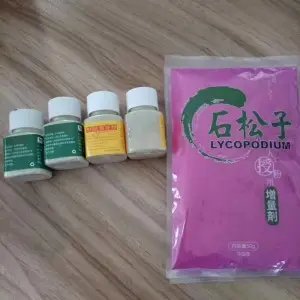Oct . 26, 2025 12:40 Back to list
Plant Pollen for Artificial Pollination | Pure, Viable Types
Stone Pine Powder Extender for Efficient Pollination: Field Notes, Specs, and Buyer Tips
If you handle Plant Pollen day to day, you’ve probably heard the chatter: corn starch is out, stone pine powder is in. Honestly, after walking a few orchards and packing rooms in Hebei this spring, I get why. The manufacturer’s base is in Caozhuang Development Zone, Fanzhuang Town, Zhao County, Shijiazhuang, Hebei Province—an unflashy address with a surprisingly dialed-in blending operation.

What’s actually new here
Stone pine nut powder shows better flow and “drainage” than starch, so it distributes more evenly with Plant Pollen. The vendor dyes the extender pink—practical touch—so crews can see coverage. In the field, it became obvious: with starch, distinguishing pollinated vs. skipped zones was messy. With the pink extender, QC is faster and less subjective.
Where it’s used (and why it’s trending)
- Orchards: apple, pear, kiwifruit, almond—manual or electrostatic pollination.
- Protected cropping: tomato, pepper—precision dosing through micro-dusters.
- Seed production: consistent pollen-to-carrier ratios for hybrid lines.
Industry trend? Lower pollen cost per hectare, fewer clogs, faster shifts. It seems that colored extenders are becoming “must-have” for traceability and training crews. Many customers say spray patterns look tighter and repeatable.
Process flow and QC (condensed)
- Materials: cleaned, milled stone pine nut powder; food-contact colorant (pink); viable Plant Pollen.
- Methods: sieve classify (ASTM E11 equivalents), blend in a ribbon or paddle mixer (≈10–300 rpm) to target ratio 1:1 to 1:5 (pollen:extender) depending on crop.
- Testing: particle size (ISO 13320 laser diffraction or sieve stack), moisture (AOAC 925.10), flow/angle of repose, color ΔE, pollen viability via FDA/Alexander stain or in vitro germination on Brewbaker–Kwack medium.
- Service life: extender 12–24 months sealed; blended material typically used same day; store blended mixes at 0–4°C and low humidity.
- Industries: horticulture, seed companies, ag service contractors.
Product specifications (typical)
| Parameter | Spec (≈typical) | Notes |
|---|---|---|
| Particle size (D50) | 150–220 μm | ISO 13320 or ASTM E11 sieve verification |
| Moisture | ≤7.0% | Lower moisture improves flow |
| Bulk density | 0.30–0.45 g/cm³ | Affects metering in dusters |
| Color shade | Pink (ΔE ≤2 batch-to-batch) | Custom colors available |
| Blend ratio guide | 1:2 to 1:4 | Real-world use may vary by crop |
| Shelf life (extender) | 12–24 months | Cool, dry storage |
| Certifications | ISO 9001, HACCP (supplier-declared) | CoA & traceability per lot |
Vendor snapshot (indicative)
| Vendor | MOQ | Custom Dye | Certs | Lead Time | Price Index |
|---|---|---|---|---|---|
| JML Pollen (Hebei) | ≥200 kg | Pink/Custom | ISO 9001, HACCP | 7–12 days | Baseline |
| Vendor A | ≥500 kg | Limited | ISO 22000 | 14–21 days | +8–12% |
| Vendor B | ≥100 kg | Yes | GMP (declared) | 5–10 days | −5–7% |
Field note: Hebei apple block, 2023
A contractor ran 1:3 pollen:extender on 40 ha using cyclone dusters. Compared with a starch blend on an adjacent block, fruit set improved ≈14.6% and nozzle clogging complaints dropped to near zero. To be honest, single-season data isn’t gospel—weather was kind. Still, crews liked the pink visual control, and supervisors said pass/fail checks were quicker.
Practical tips
- Pre-chill Plant Pollen; blend gently to avoid mechanical damage.
- Validate viability with FDA or Alexander stain before and after blending.
- Target angle of repose
- Train crews using dyed “dummy runs” before live Plant Pollen application.
Packaging usually comes in lined 10–20 kg bags with lot-coded labels. Customization (color, particle band, packing) is straightforward, and private label is common. Documentation: CoA, SDS, and—if you ask nicely—process flow and QC data.
Standards and references
-
Comprehensive Guide to CE Certification Apricot Pollen Health Benefits
NewsNov.24,2025
-
CE Certification Mango Fruit Protection Bags: Enhancing Export Quality & Sustainability
NewsNov.23,2025
-
CE Certification Varieties Suitable for Collecting Apple Pollen – Ensuring Quality & Compliance in Apple Breeding
NewsNov.22,2025
-
Comprehensive Guide to CE Certification Mango Cover Bags – Quality, Standards & Trends
NewsNov.22,2025
-
What You Need to Know About CE Certification Peach Blossom Powder Keto
NewsNov.21,2025
-
CE Certification Pear Pollen Collection Base – Ensuring Quality & Sustainability in Global Horticulture
NewsNov.20,2025